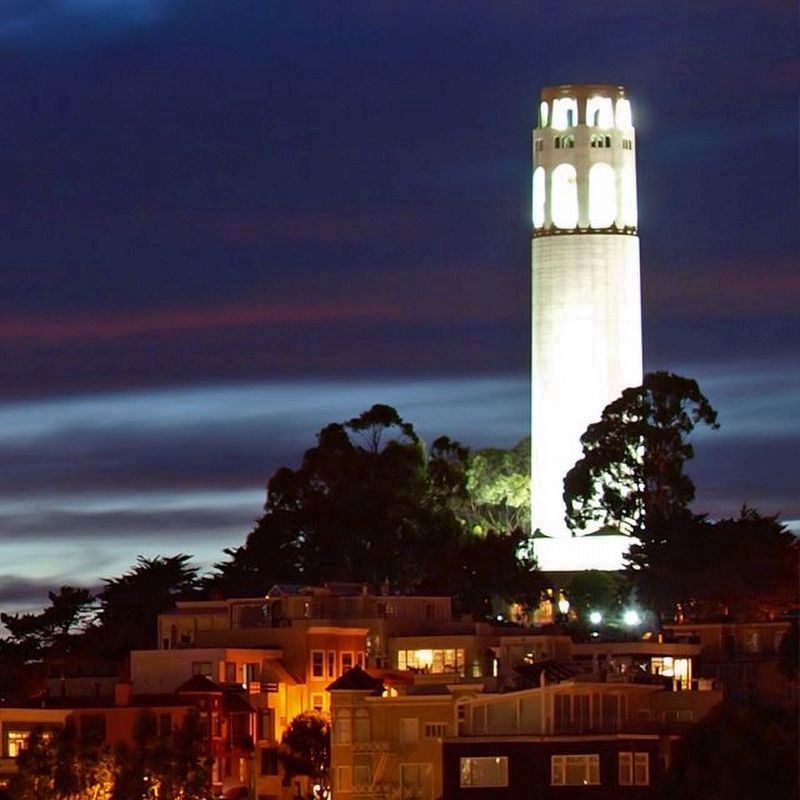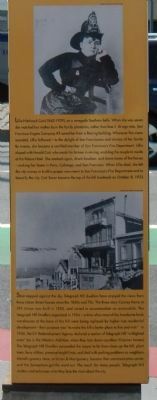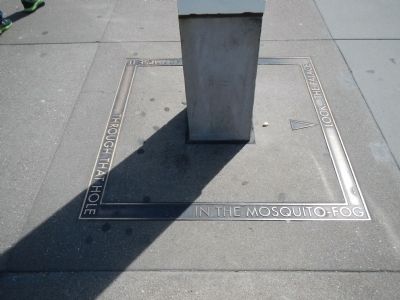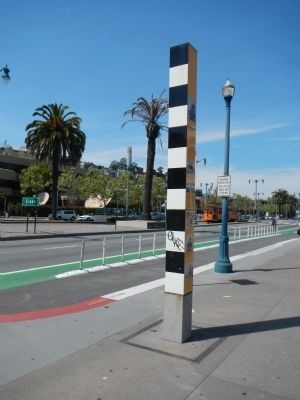Northern Waterfront in San Francisco City and County, California — The American West (Pacific Coastal)
Telegraph Hill
The marker is primarily composed of photographs and illustrations and the captions that accompany them. Photographs or illustrations are sequentially numbered from the top.
For ships coming through the Golden Gate, Telegraph Hill could be spotted as the first unmistakable landmark to welcome them to San Francisco. The marine signal on top of the hill used semaphore arms to show anxious citizens at a glace whether an incoming vessel was a side-wheel steamer (bringing in passengers and mail), or a barque (loaded with everything from fish-hooks to billiard balls) or a sloop of war (greeted with a cannon salute and evening festivities). Anyone who wanted to see “everything” has to climb the slopes of Telegraph Hill – and there it was, spread out below. From the city’s beginnings, the hill was a place to live.
Photograph 1
July 4th, 1891: lumber schooner racing off Telegraph Hill.
Illustration 2
“San Francisco at night is unlike anything I ever beheld. Houses mostly made of canvas, made transparent by light from within, and transformed in the darkness to dwellings of solid light... tents pitched among the chaparral to its summit, it gleamed like an amphitheater of fire.” – Bayard Taylor, Reporting to New York Tribune, 1949
Photograph 3
The intrepid builder of this carpenter-Gothic home on the high northern reaches of Telegraph Hill, traded convenience for an encompassing view that included the Golden Gate, Fort Alcatraz, and “Honest Harry” Meiggs’s Wharf. Built on San Francisco Street, between Stockton and Dupont, this handsome four-gabled home appears in 1862; its architectural style is that of San Francisco homes from the late 1850’s up through the Civil War. At that time, Telegraph Hill and North Beach were international communities, with the French living next door to the Swiss, and the Italians over the fence from the Germans, and the Irish scattered about in between, while New England Yankees could be found everywhere.
Photograph 4
Living on the hill meant having your own small place. It meant climbing steep stairs to bring home groceries, on stairways without gaslights, with an out-house on the back porch. You had to love the hill to live there. For the most part, living on Telegraph Hill remained cheap-to-reasonable, precisely because of its steep ups and downs. From the 1880s through 1910, the hill became more Irish and Italian – with Italian settling the south slopes above North Beach.
It was possible to find inexpensive housing right up through World War II. But by the 1950s a place on the hill, with a view and reasonable rent became a treasure that friends passed on to friends. About the same time, carefully tended flower gardens began to bloom in profusion where only backyard paths had been before. Grace Marchant’s Filbert Steps garden added roses, baby tears, fuchias, and datura bells to the private delight of cats and the public’s pleasure.
Photograph 5
Lillie Hitchcock Coit (1842-1929), was a regarded Southern belle. When she was seven she watched her mother burn the family plantation, rather than lose it. At age nine, San Francisco Engine Company #5 saved her from a flaming building. Whenever fire sirens sounded, Lillie followed – to the delight of San Franciscans and the dismay of her family. By twenty, she became a certified member of San Francisco’s Fire Department. Lillie eloped with Harold Coit, who made his fortune in mining, enabling the couple to reside at the Palace Hotel. She smoked cigars, drank bourbon, and drove teams of fire horses – making her home in Paris, Calistoga, and San Francisco. When Lillie died, she left the city money to build a proper monument to San Francisco’s Fire Department and to beautify the city. Coit Tower became the top of the hill landmark on October 8, 1933.
Photograph 6
Stair-stepped against the sky, Telegraph Hill dwellers have enjoyed the views from these Union Street houses since the 1860s and 70s. The three-story Cooney home at 291 Union was built in 1850, and raised to accommodate an automobile. The Telegraph Hill Dwellers organized in 1954 – a time when most of the handsome brick warehouses at the base of hill were being replaced by higher-rise residential development – their purpose was “to make the hill a better place to live and visit.” In 1956, the S.F. Redevelopment Agency declared a section of Telegraph Hill “a blighted area” (as in the Western Addition, when they tore down countless Victorian homes.). The Telegraph Hill Dwellers persuaded the mayor to let them clean up the hill, plant trees, bury utilities, preserve height limits, and deal with parking problems as neighbors. Meisel’s grocery store, at Union and Montgomery, became their communication center and the Semaphore got the word out. The result: for many people, Telegraph Hill shelters and enhances what they love most about the city.
Embedded around the base
Look... the palace... you can glimpse it through that hole in the mosquito fog. – Issa
Erected by San Francisco Art Commission for the Waterfront Transportation Projects.
Topics. This historical marker is listed in this topic list: Landmarks. A significant historical month for this entry is July 1994.
Location. 37° 48.025′ N, 122° 23.904′ W. Marker is in San Francisco, California, in San Francisco City and County. It is in Northern Waterfront. Marker is on The Embarcadero, on the left when traveling north. Touch for map. Marker is at or near this postal address: 600 The Embarcadero, San Francisco CA 94111, United States of America. Touch for directions.
Other nearby markers. At least 8 other markers are within walking distance of this marker. Building the Seawall (a few steps from this marker); Vallejo Street (within shouting distance of this marker); Green Street (within shouting distance of this marker); Crimps and Dives (within shouting distance of this marker); Kanrin Maru (within shouting distance of this marker); Braving the Seas (about 300 feet away, measured in a direct line); Russian Navy Heroes (about 600 feet away); Pony Express Wharf (about 600 feet away). Touch for a list and map of all markers in San Francisco.
More about this marker. The marker is located on the water side of The Embarcadero between Piers 15 and 9.
Also see . . . Telegraph Hill, San Francisco. Wikipedia entry:
The hill owes its name to a semaphore, a windmill-like structure erected in September 1849, for the purpose of signaling to the rest of the city the nature of the ships entering the Golden Gate. Atop the newly built house, the marine telegraph consisted of a pole with two raisable arms that could form various configurations, each corresponding to a specific meaning: steamer, sailing boat, etc. The information
was used by observers operating for financiers, merchants, wholesalers and speculators. (Submitted on May 1, 2014, by Barry Swackhamer of Brentwood, California.)

via San Franciso Recreation and Parks, unknown
6. Coit Tower
San Francisco Recreation and Parks entry:
Coit Tower, a slender white concrete column rising from the top of Telegraph Hill, has been an emblem of San Francisco’s skyline since its completion in 1933, a welcoming beacon to visitors and residents alike. Its observation deck, reached by elevator (tickets can be purchased in the gift shop), provides 360-degree views of the city and bay, including the Golden Gate and Bay bridges.
(Submitted on May 1, 2014, by Barry Swackhamer of Brentwood, California.)
Click for more information.
Coit Tower, a slender white concrete column rising from the top of Telegraph Hill, has been an emblem of San Francisco’s skyline since its completion in 1933, a welcoming beacon to visitors and residents alike. Its observation deck, reached by elevator (tickets can be purchased in the gift shop), provides 360-degree views of the city and bay, including the Golden Gate and Bay bridges.
(Submitted on May 1, 2014, by Barry Swackhamer of Brentwood, California.)
Click for more information.
Credits. This page was last revised on February 7, 2023. It was originally submitted on May 1, 2014, by Barry Swackhamer of Brentwood, California. This page has been viewed 876 times since then and 55 times this year. Photos: 1, 2, 3, 4, 5. submitted on May 1, 2014, by Barry Swackhamer of Brentwood, California. 6. submitted on June 14, 2021, by Larry Gertner of New York, New York. • Bill Pfingsten was the editor who published this page.




